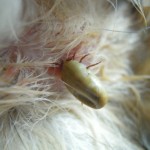
September 28th is World Rabies Day.
Did you know that an estimated 70,000 people die annually from rabies? In 2013, the Canadian Food Inspection Agency (CFIA) reported 116 cases of rabies in both wild and domestic animals in our country. Common wild animals that transmit this viral disease are bats, skunks, racoons and foxes. Exposure to rabid dogs is the cause for over 90% of human cases of rabies and of over 99% of human deaths due to rabies worldwide. Traditionally rabies has had no treatment, and was thought to be fatal, once neurological symptoms start. Post exposure prophylactic treatment, BEFORE symptoms develop, has been the best defense against the disease progression. This includes post exposure vaccinations and rabies immunoglobulin injections in a set scheduled protocol. In 2004, rabies was successfully treated using the Milwaukee Protocol in a 15 year old girl exposed to a rabid bat. She did not seek post exposure treatment and when symptoms started, doctors induced a coma and began aggressive antiviral therapies. Since then, this technique has been successful in only a few other patients and the mortality rate from rabies is still very high.
Rabies is preventable, which is why it’s vital for our pets to be up-to-date on their vaccinations. This helps prevent rabies from infecting both our animals and ourselves. In addition, any pet that has been bitten or otherwise exposed to a potential rabies carrier, should seek veterinary assistance immediately. Quarantine protocols are in place for post rabies exposure situations, to keep both the pet and the public safe from harm. In the case of human exposure to a potentially rabid carrier, it is very important to seek medical attention immediately for proper preventive therapy.
Some places, it is mandatory to have your pets vaccinated for rabies. Fines may be issued for those that do not heed this law. Although in the city of Calgary it is not mandatory, it is strongly recommended in an effort to protect both the pet and the public. At Midlake Veterinary Clinic we vaccinate any puppy or kitten over the age of 12 weeks, then provide a booster vaccine one year later. Typically dogs are vaccinated every three years thereafter. If owners prefer, rabies titre testing for antibodies can be done as an alternative.
To find out more about World Rabies Day please visit the Center for Disease Control website at www.cdc.gov/worldrabiesday






